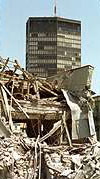|
|
|
 |
 |
|
 |
| ANNIVERSARY OF SHAME: MARCH
1999-MARCH 2002 |
 |
|
Bayronica, March 2002 |
 |
| On March 24 Serbian people around the world will recall
with horror the shameful destruction of their country by the
US led NATO Alliance. Three years ago, for 78 days and
nights, NATO aircraft pounded Yugoslavia inflicting terrible
damage on the civilian infrastructure of the country. |
|
 |
 |
 |
| The
use of cluster bombs and weapons containing depleted uranium
caused hundreds of civilian deaths and injuries. The
psychological scars inflicted on the people may never be
reconciled. This was an illegal and unjustified act of blatant
aggression. That it was carried out by the democratic nations of
Western Europe and North America only added to the bewilderment
and horror. |
 |
 |
 |
| The
ongoing trial of the former Serbian President, Slobodan
Milosevic, can only be seen as a desperate attempt to justify
NATO’s criminal actions. It will not succeed. The legacy of
Madeline Albright’s war will be the dishonour it has brought to
the North Atlantic Treaty Organization. Kosovo was NATO’s fatal
error. |
 |
 |
 |
| For
more than forty years, The North Atlantic Treaty Organization
protected the West from the very real threat of aggressive
Soviet communism. It was an organization respected and admired
by all free men. NATO was more than just a powerful military
alliance. It was founded on a bedrock of morality and high
principle. It stood for the principles of the United Nations
Charter. It stood for democracy, for the rule of law and for all
of those things our fathers and grandfathers had fought for in
two cataclysmic World Wars. All of this changed in the spring of
1999 when NATO bombers launched its unprovoked and illegal
assault against the sovereign state of Yugoslavia. |
 |
 |
 |
| The idea for NATO
grew out of a suggestion proposed in 1948 by the Canadian
Minister of Foreign Affairs, Louis St. Laurent, that the
European Defense Alliance of five European countries be expanded
to include the United States and Canada. A year later in April
1949 the treaty was signed in Washington and NATO was born. |
 |
 |
 |
| NATO
was a defensive alliance. The first article of the Treaty made
this clear. Article 1 read in part, “ The parties undertake, as
set forth in the Charter of the United Nations, to settle any
international dispute in which they may be involved, by peaceful
means in such a manner that international peace and security and
justice are not endangered…and to refrain in their international
relations from the threat or use of force in any manner
inconsistent with the purposes of the United Nations.” |
 |
 |
 |
|
After the collapse of the Soviet Union and the demise of the
Warsaw Pact forces in Eastern Europe the reason for NATO’s
continuing existence began to come under serious scrutiny. Why
maintain such a large and expensive military organization in
Western Europe when any threat from the former Soviet Union had
evaporated? Before this question could be resolved, however, a
new role for the Alliance was discovered. The violent breakup of
the Federal Republic of Yugoslavia in the early 1990’s provided
NATO with a new mission- that of peace keeping. |
 |
 |
 |
| As violence and bloodshed
spread in Croatia and Bosnia, the peacekeeping role turned
into direct military action. Under the leadership of the
United States, NATO intervened in the civil war in
Yugoslavia and carried out air strikes against Serbian
forces in Croatia and Bosnia. These air strikes were not
conducted for defensive purposes. None of the NATO countries
was threatened by the Yugoslav conflict. |
|
 |
|
 |
 |
 |
|
However, the strikes were carried out with the authority and
approval of the Security Council of the United Nations.
Therefore, while clearly in violation of the spirit of Article 1
of NATO’s Treaty, it could be argued the military action was in
keeping with the purposes of the United Nations.
After Bosnia there was no further talk about dismantling
NATO. On the contrary, the air strikes had given new life to the
organization. Now the talk was of expansion and for new missions
to be undertaken. NATO was on a slippery slope. |
 |
 |
 |
| Armed
rebellion in the Serbian Province of Kosovo, [fomented as we now
know by the intelligence services of at least three of the NATO
countries] provided the United States with the opportunity of
employing NATO in an attempt to bring down the despised Serbian
leader, Slobodan Milosevic. Using as an excuse its failure to
sign the infamous Rambouillet Agreement, NATO began to bomb
Yugoslavia in March 1999. The bombing continued for 78 days
until a peace treaty was brokered by the Russians and the United
Nations. |
 |
 |
 |
| The
bombing was a violation of NATO’s First Article, a violation of
the United Nations Charter and contrary to international law.
Ironically- and shamefully- none of the democratic leaders of
NATO member countries [with the exception of Greece] challenged
the US led bombing. When Madeline Albright, the United States
Secretary of State, was informed shortly before the bombing by
the British Foreign Secretary, Robin Cooke, that lawyers in his
Ministry believed the bombing to be illegal if done without UN
approval, she abruptly dismissed his concern by telling him to,
“Get new lawyers!” |
 |
 |
 |
While
the bombing continued, NATO celebrated its fiftieth birthday in
Washington. This was the occasion to announce a new “Strategic
Concept” for the organization. Now there was no reference to
Article 1 of the Treaty, no mention of settling international
disputes by peaceful means or complying with the principles of
the United Nations. NATO was no longer a “defensive
organization.” It was to be modernized and made ready for the
new century. The niceties of international law and the
formalities of obtaining UN approval before intervening in the
domestic affairs of a sovereign state were to be set aside in
favour of, “conflict prevention,” of
“crisis management,” and “ crisis response operations. ” |
 |
 |
 |
| These are the
buzzwords that have turned the original treaty upside down. But
nobody seems to care. We now have a “treaty on wheels” that can
be used for whatever purposes the United States wants it to be
used for. Wheel it out whenever it is convenient and use it when
it is awkward to obtain legislative authority to wage war. A sad
state of affairs and a dreadful indictment of the readiness of
today’s political leaders to mould international instruments and
treaties in whatever image serves their immediate needs. |
 |
 |
|
| If a Treaty is to be
amended or changed it must be approved and ratified by the
legislatures of the contracting states. This has not been done
in the case of the North Atlantic Treaty and it is unlikely it
will be done. NATO has become just another tool of American
foreign policy. It serves as a useful political cover to justify
United States use of military power. |
 |
 |
 |
|
 |
| NATO’s bombing of Yugoslavia will be
regarded by future historians as the act that completely
dismantled the international security framework so carefully
crafted by democratic statesmen in the aftermath of two
World Wars and the advent of nuclear weapons. It will be
marked, as the point in history when other so-called
democratic leaders acted dishonorably to set the clock back
to the days prior to the Second World War when military
might was the only criterion that counted in the conduct of
international relations. |
|
|
 |
|
|

